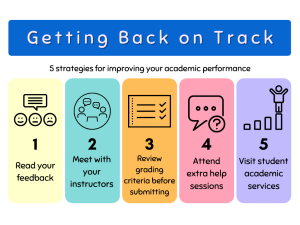Chapter 2: You and Your Education
16 Grades
If you have ever been in school in the past, you are likely familiar with receiving grades for the work you have completed. Here at Cambrian, instructors assign number grades based on your performance in the class. These impact your overall grade point average, or GPA. You can think of your GPA as an average overall grade, which determines your academic standing. Keeping your academic standing above a 2.0 GPA (or a 60% average) is important to avoid being placed on academic probation.
The chart below shows how Cambrian converts your grades into points in order to calculate GPA. For more information, visit the webpage Transcripts, GPA, and Policies.
| Grade | Point Description* |
|---|---|
| A 80% to 100% | Course objectives are met in a consistently outstanding manner (4 pts.) |
| B 70% to 79% | Course objectives are met in a consistently thorough manner (3 pts.) |
| C 60% to 69% | Required course objectives have been met (2 pts.) |
| D 50% to 59% | Limited fulfillment of course objectives with weakness in some or all areas (1 pt.) |
| F Less than 50% | Course objectives have not been met, credit is not granted (0 pts.) |
| AU | Course has been audited, credit is not granted (0 pts.) |
Adjusting Your Expectations
The reality is that most people struggle with making the jump to college learning and it is normal for grades to drop. College can bring about new ways of learning and new expectations. Usually, students will see the largest change in their grades in the first term of their first year. Don’t let this discourage you!
If you find your grades dropping or you are receiving multiple poor grades, consider the following:
- Assess your progress as you go through the course and ask for help when you need it (before it is too late).
- Accept that it’s ok to perform poorly or have your grades drop but what’s important is what you do to get yourself back on track. Make a plan right away! You may want to get a tutor for a certain course or decide to go to office hours every week, etc.
- If a course is really not going well, you may need to consider dropping it to avoid academic penalties (be mindful of important dates to drop courses, and make sure to check in with an academic advisor to make sure you’re ok to drop the course).
- If you do poorly on a test or an assignment worth a large percentage, you can talk to your professor/instructor about your options moving forward in the course.
Get Back on Track

You can also use a grade calculator to help you to determine the impact a low grade will have on your overall course grade or GPA. This one, created by ON Tech U, also allows you to set goals.
So, You Failed a Course
Uh oh, you failed a course. You’re probably feeling a mixture of frustration, guilt, shame, anger, disappointment, etc. Of course, no one wants to fail a course, but it does happen. The first thing you should do (after you feel your feelings and vent to your friends) is to speak to your academic success advisor and ask the following questions:
- How can you get back on track?
- Do you need to retake that specific course, or can you make it up with a different course?
- Is the course offered next term?
- Is there a cost associated with taking the course again?
Once you have some of the logistics figured out, it is time to reflect on the experience and your actions. Think about:
- What happened to lead to this result? Is it something you could control?
- What do you need to do to get back on track and make sure this doesn’t happen again?
- What tangible steps can you take to avoid getting off track in the future?
The Learning Centre at Cambrian can also be a great resource for help during this time, including free tutoring in a wide range of subjects to help you get back on top of your courses.
Handling Setbacks
When a setback happens (and one will happen at some point), it’s important to know how to handle them. Let’s take a look at some ideas.
How to deal with setbacks image text:

- Ask questions and communicate with others
- Admit to mistakes and take responsibility
- Expect discomfort
- Keep a positive attitude
- Accept constructive criticism
- Take care of yourself

